Pennsylvania is a sizeable state that is home to cities and massive rural expanses. With a few hours of driving, you can find yourself in the Electric City or standing on the shores of Lake Erie. As one might imagine, the diversity in habitats offered by this state means that its home to several different creatures, including spiders. Today, we will examine 5 of the biggest spiders in Pennsylvania.
You’ll learn where you’re like to encounter these creatures, how large they can grow, and if they pose any threat to you or your family if they bite. We’ll also tell you which spiders you need to be warier of should you encounter them in the wild.
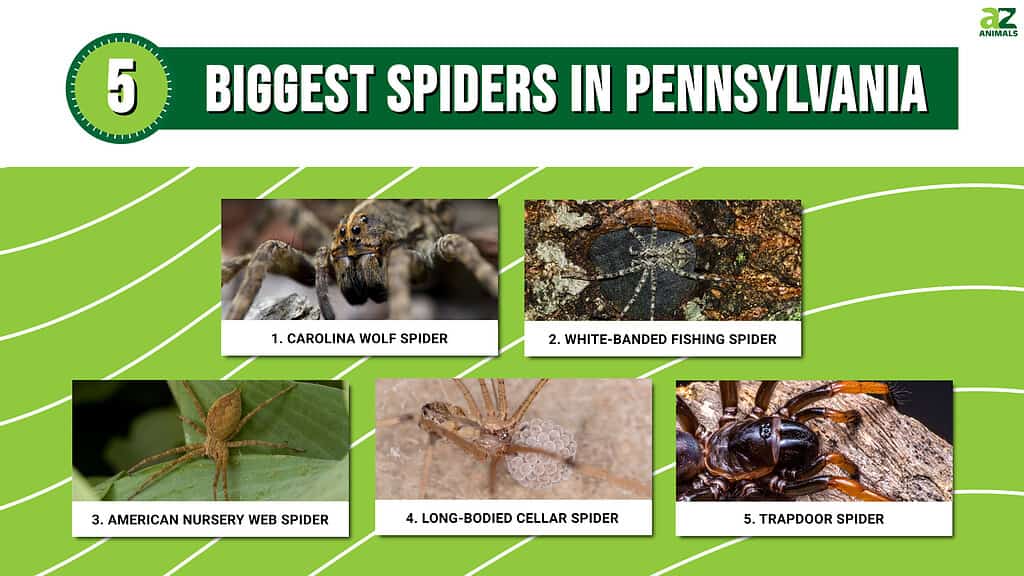
What Are The Biggest Spiders In Pennsylvania?
The biggest spiders in Pennsylvania aren’t nearly as large as those found in the Southwest. You’ll not find tarantulas lurking in Lancaster County or any huntsman spiders in the basements of Philadelphia’s shops. That doesn’t mean you won’t be interested to learn that a 4-inch-long spider could be hunting down insects in your basement, though.
Let’s take a closer look at the biggest spiders in the region and how you can tell them apart.
5. Trapdoor Spider
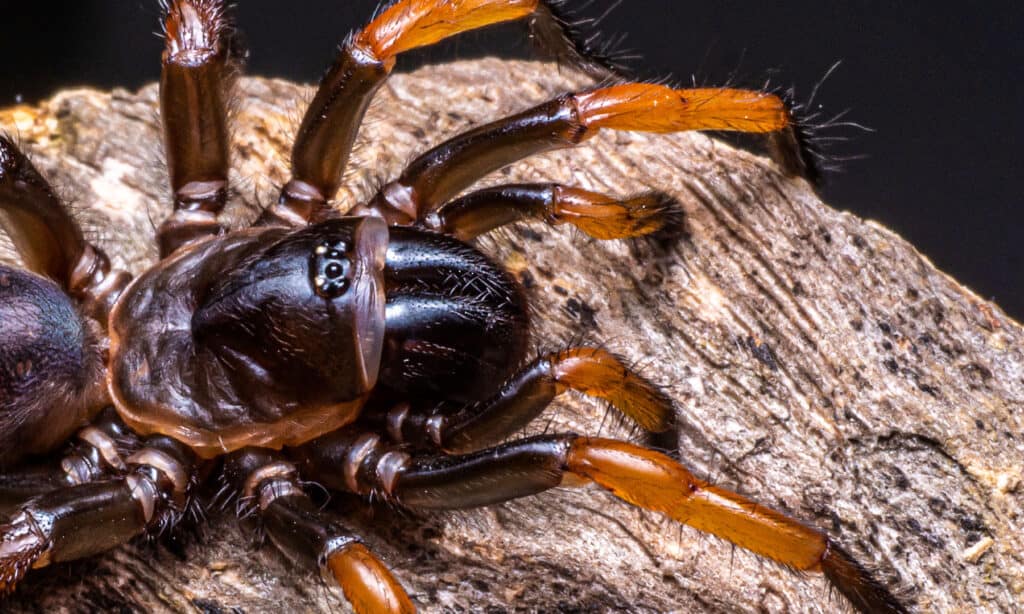
Trapdoor spiders are experts at making burrows.
©nokkaew/Shutterstock.com
| Scientific Name | Size | Danger to Humans |
|---|---|---|
| Ummidia genus | 1-2 inches | Delivers a mildly painful bite. |
The trapdoor spider of the Ummidia genus is an interesting creature that hunts from its deep, web-lined burrow. These spiders are not commonly seen because they often spend time in their burrows digging or waiting to catch their prey.
They are large, black spiders with a shiny black cephalothorax, and a hairy, dark brown abdomen. When you look at one of these creatures, you may think that they’re tarantulas because of their bulbous backside. However, they are far smaller than most tarantulas, and they are not likely to harm a person.
In the rare event that you get bitten by a trapdoor spider, you will experience mild pain at the site where you were bitten. Aside from that, you don’t have to worry about their bites.
4. Long-Bodied Cellar Spider
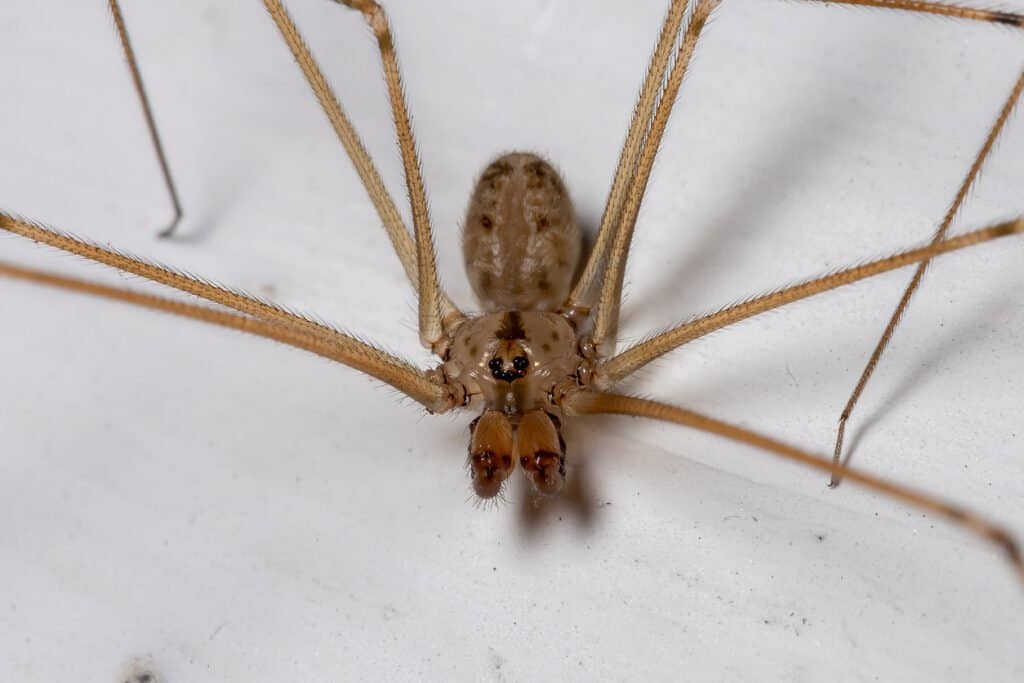
Cellar spiders share the name daddy long legs with harvestman arachnids.
©iStock.com/ViniSouza128
| Scientific Name | Size | Danger to Humans |
|---|---|---|
| Pholcus phalangioides | 1-2 inches | A bite may cause a mild burning sensation. |
The cellar spider is one of the most common in homes and basements throughout the United States. Cellar spiders are not likely to cause you any harm. They will avoid interactions with humans as best as they can. If one does bite you, then you can expect some pain in the form of a mild burning sensation.
Many people are frightened of long-bodied cellar spiders because of their looks and the urban legends about them. Regarding the former, cellar spiders have a translucent body that looks light brown, gray or a mix of gray and brown. They have a bulbous abdomen that seems to make up much of their total body length and some very long legs.
The combined effects of their looks are enough to frighten people. However, an urban legend and a case of mistaken identity have made these spiders seem more dangerous than reality shows. Don’t worry, though. These daddy long legs are not venomous enough to kill a person, and neither is the harvestman.
3. American Nursery Web Spider
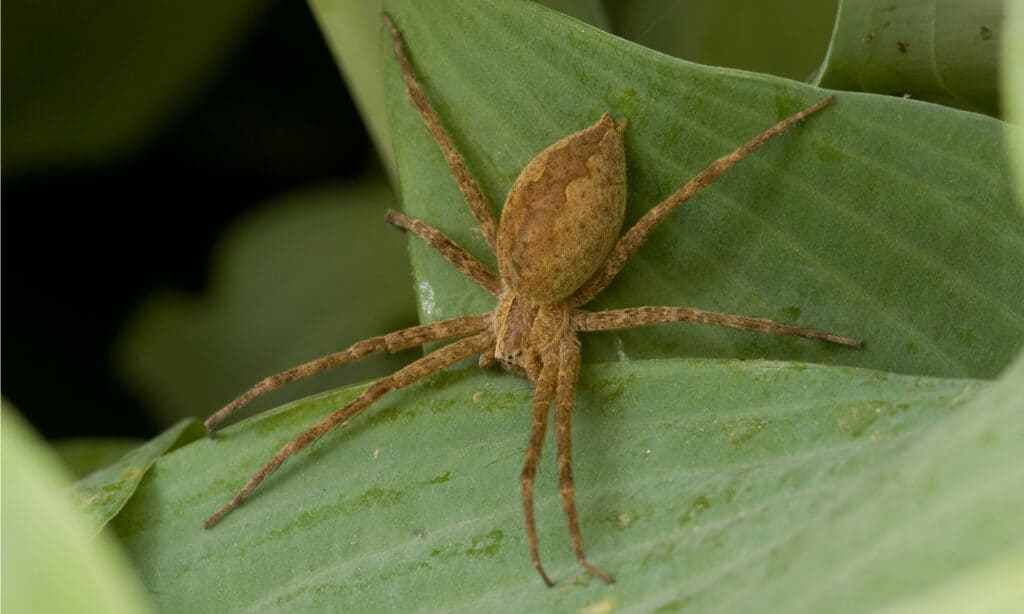
Male American nursery web spiders will tie females’ legs during mating to avoid being eaten afterward.
©SDeming/Shutterstock.com
| Scientific Name | Size | Danger to Humans |
|---|---|---|
| Pisaurina mira | 1-3 inches | Has a bite that is mostly harmless to humans, with pain and swelling common. |
The American nursery web spider has some unique behaviors that make it fun to learn about. For one thing, the females will build a pouch made from their web to house their eggs when they are about to hatch. That’s the origin of the ‘nursery web’ in their common name.
Another interesting fact is that these spiders are sexually cannibalistic. The females will try to eat the males after they mate. Aside from that, these spiders can grow somewhat large, up to 3 inches, with their legs stretched out.
They don’t attack humans very often, though. They prefer to live in tall grass, around woods, and in the shrubs near homes. If they bite a person, the bite will swell and ache for a little while.
2. White-Banded Fishing Spider
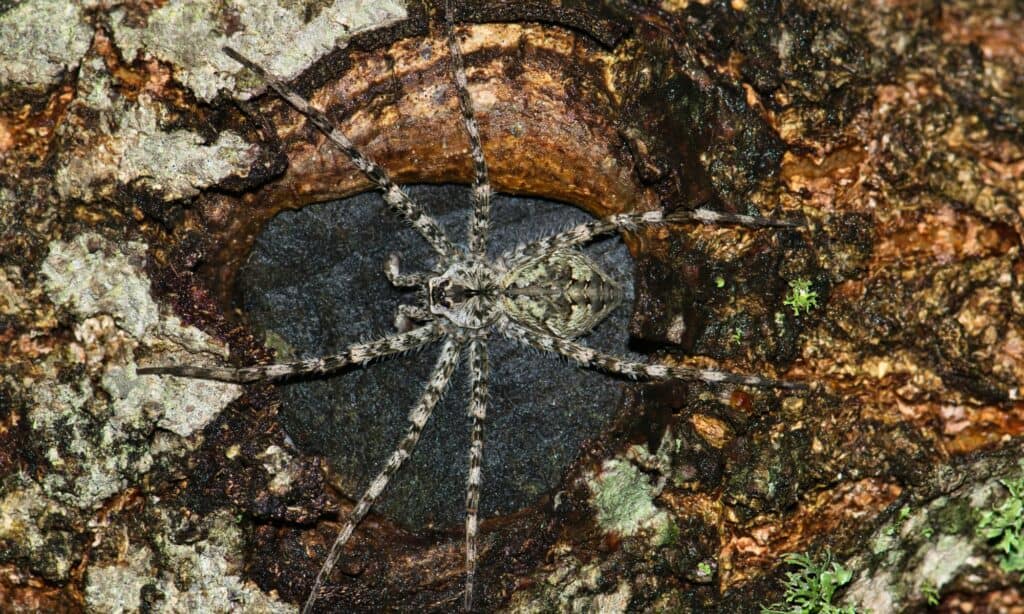
The white-banded fishing spider has regional differences in its coloration, so it can be very dark.
©iStock.com/Brett_Hondow
| Scientific Name | Size | Danger to Humans |
|---|---|---|
| Dolomedes albineus | 1-2.5 inches | May inflict a mildly painful bite if bothered. |
The white-banded fishing spider is another interesting spider to learn about and look at. Oftentimes, the spider will have a white body with a few black markings along with legs that are primarily white with black banding on them.
These spiders spend significant amounts of time near or on the water. They hunt down aquatic insects by running out onto the water and catching them or trapping air along their abdomen to dive below the water to attack small aquatic animals.
Even though they are very dangerous to their prey, they are not dangerous to humans. They will run away at the sight of a large creature, like people. Though rare, they can bite, but an attack will only cause some redness along with moderate pain.
1. Carolina Wolf Spider
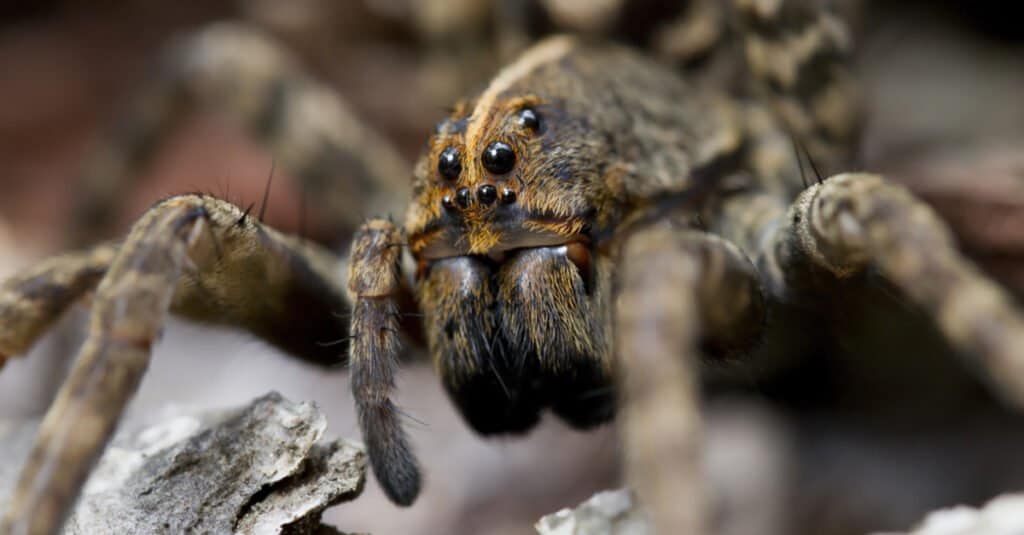
Carolina wolf spiders are among the largest wolf spiders.
©Will E. Davis/Shutterstock.com
| Scientific Name | Size | Danger to Humans |
|---|---|---|
| Hogna carolinensis | 2-4 inches | The bite causes local pain and swelling. |
The Carolina wolf spider is one of the biggest spiders in Pennsylvania, second only to the dark fishing spider. Nevertheless, it’s the largest one in its genus, and that deserves mentioning.
The Carolina wolf spider is often dark brown or black with a gray or light brown color that runs along the sides of the cephalothorax and abdomen. It also has a light stripe that runs down the middle of its abdomen.
These creatures do not use their webs to trap prey. Instead, they hide in their burrows or in areas where insects live and ambush them. They can bite humans in some cases, causing some pain and swelling in the bite area. However, they are more likely to skitter away and avoid the potential danger.
Now that we have covered the biggest spiders in Pennsylvania, it’s clear that the big ones aren’t much to worry about. That doesn’t mean Pennsylvania doesn’t have dangerous spiders. In fact, black widow spiders are native to the state, and they can cause serious complications for humans.
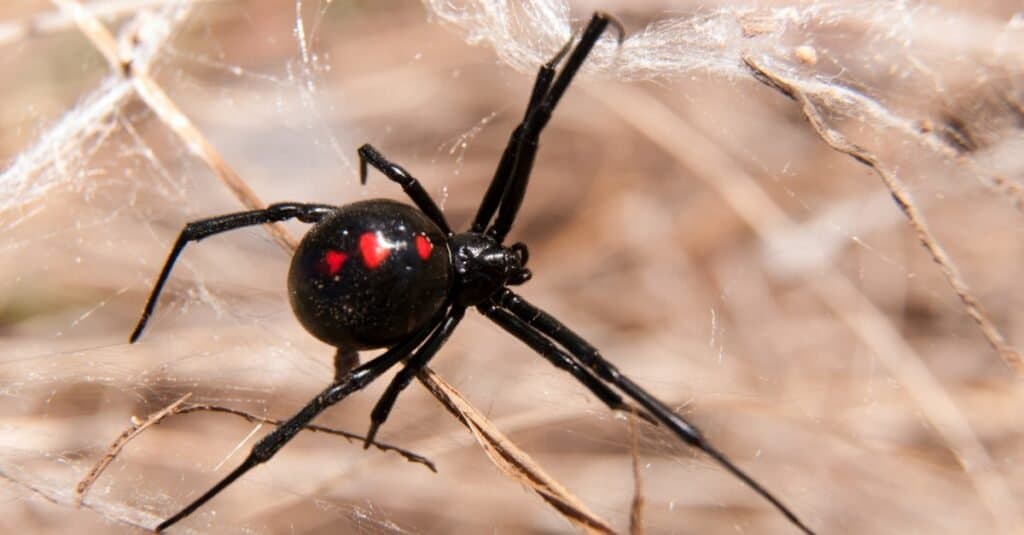
Black widow spiders aren’t among the largest spiders in Pennsylvania but they can certainly be found there.
©Sari ONeal/Shutterstock.com
The brown recluse is very rarely found in the state, but it’s possible to encounter them. Both spiders should be avoided and approached with serious caution, even if you’re trying to exterminate them.
Summary Of The 5 Biggest Spiders In Pennsylvania
| Rank | Spider | Size in Length |
|---|---|---|
| 1 | Carolina Wolf Spider | 2-4 inches |
| 2 | White-Banded Fishing Spider | 1-2.5 inches |
| 3 | American Nursery Web Spider | 1-3 inches |
| 4 | Long-Bodied Cellar Spider | 1-2 inches |
| 5 | Trapdoor Spider | 1-2 inches |
Bonus: Big Spiders in Pennsylvania
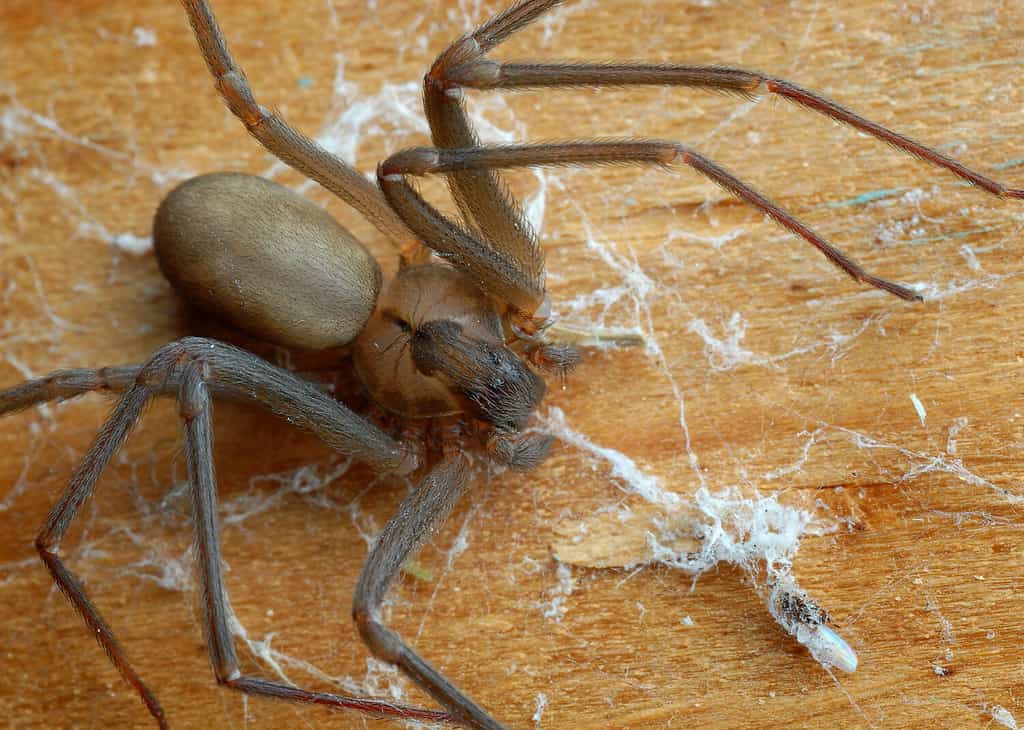
Brown recluse spiders have a clean violin shape on the front part of their body.
©Miles Boyer/Shutterstock.com
Here are some other spiders found in Pennsylvania that did not make the list:
- Brown recluse spider
- Orb-weaver spiders
- Wolf spider
Brown recluse spiders, also known as violin or fiddle-back spiders (Loxosceles), typically measure around 1.25 cm in length and feature a distinctive dark violin-shaped marking on their fused head and midsection, known as the cephalothorax.
In fact, a pencil measures 7.5 inches in length. Female golden orb weavers range from 2 to 6 inches in size, while males are smaller, measuring between 0.5 to 2 inches long.
Furthermore, wolf spiders exhibit a range of sizes, with the majority having a body length that spans from one-quarter of an inch to over 1 ½ inches.
The photo featured at the top of this post is © Will E. Davis/Shutterstock.com
Thank you for reading! Have some feedback for us? Contact the AZ Animals editorial team.






